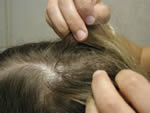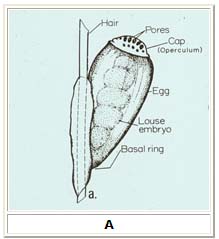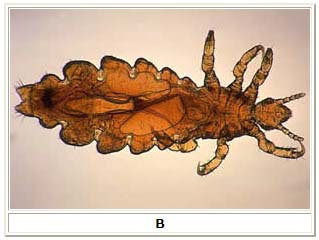Head Lice Infestation physical examination: Difference between revisions
(Created page with "__NOTOC__ {{Head Lice Infestation}} {{PleaseHelp}} ==References== {{reflist|2}} Category:Infectious disease Category:Disease") |
No edit summary |
||
| Line 1: | Line 1: | ||
__NOTOC__ | __NOTOC__ | ||
{{Head Lice Infestation}} | {{Head Lice Infestation}} | ||
{{ | {{CMG}} | ||
==Overview== | |||
[[Image:Hair lice.jpg|left|Searching for lice in hair]] | |||
An infestation is diagnosed by looking closely through the hair and scalp for nits, nymphs, or adults. Finding a nymph or adult may be difficult; there are usually few of them and they can move quickly from searching fingers. If crawling lice are not seen, finding nits within a 1/4 inch of the scalp confirms that a person is infested and should be treated. | |||
==Physical Examination== | |||
If you only find nits more than 1/4 inch from the scalp (and don't see a nymph or adult louse), the infestation is probably an old one and does not need to be treated. If you are not sure if a person has head lice, the diagnosis should be made by your health care provider, school nurse, or a professional from the local health department or agricultural extension service. | |||
<br clear="left"/> | |||
[[Image:H nit.jpg|left|Nit drawing]] | |||
'''A: Head Lice: Nit''' | |||
Nits are head lice eggs. They are hard to see and are often confused for dandruff or hair spray droplets. Nits are laid by the adult female and are cemented at the base of the hair shaft nearest the scalp. They are 0.8 mm by 0.3 mm, oval and usually yellow to white. Nits take about 1 week to hatch (range 6 to 9 days). Viable eggs are usually located within 6 mm of the scalp. | |||
<br clear="left"/> | |||
[[Image:Adult female louse.jpg|left|Adult female louse]] | |||
'''B: Head Lice: Adult female louse''' | |||
The adult louse is about the size of a sesame seed, has 6 legs (each with claws), and is tan to grayish-white. In persons with dark hair, the adult louse will appear darker. Females lay up to 8 nits per day. Females are usually larger than males. | |||
<br clear="left"/> | |||
==References== | ==References== | ||
{{reflist|2}} | {{reflist|2}} | ||
{{WH}} | |||
{{WS}} | |||
[[Category:Disease]] | |||
[[Category:Infectious disease]] | [[Category:Infectious disease]] | ||
[[Category: | [[Category:Primary care]] | ||
Revision as of 14:59, 10 August 2015
|
Head Lice Infestation Microchapters |
|
Diagnosis |
|---|
|
Treatment |
|
Case Studies |
|
Head Lice Infestation physical examination On the Web |
|
American Roentgen Ray Society Images of Head Lice Infestation physical examination |
|
Risk calculators and risk factors for Head Lice Infestation physical examination |
Editor-In-Chief: C. Michael Gibson, M.S., M.D. [1]
Overview

An infestation is diagnosed by looking closely through the hair and scalp for nits, nymphs, or adults. Finding a nymph or adult may be difficult; there are usually few of them and they can move quickly from searching fingers. If crawling lice are not seen, finding nits within a 1/4 inch of the scalp confirms that a person is infested and should be treated.
Physical Examination
If you only find nits more than 1/4 inch from the scalp (and don't see a nymph or adult louse), the infestation is probably an old one and does not need to be treated. If you are not sure if a person has head lice, the diagnosis should be made by your health care provider, school nurse, or a professional from the local health department or agricultural extension service.

A: Head Lice: Nit
Nits are head lice eggs. They are hard to see and are often confused for dandruff or hair spray droplets. Nits are laid by the adult female and are cemented at the base of the hair shaft nearest the scalp. They are 0.8 mm by 0.3 mm, oval and usually yellow to white. Nits take about 1 week to hatch (range 6 to 9 days). Viable eggs are usually located within 6 mm of the scalp.

B: Head Lice: Adult female louse
The adult louse is about the size of a sesame seed, has 6 legs (each with claws), and is tan to grayish-white. In persons with dark hair, the adult louse will appear darker. Females lay up to 8 nits per day. Females are usually larger than males.